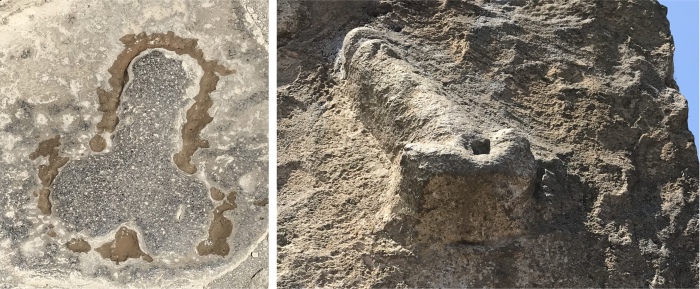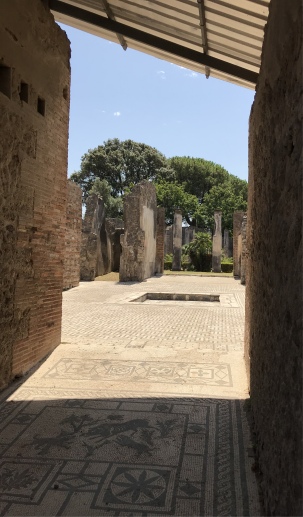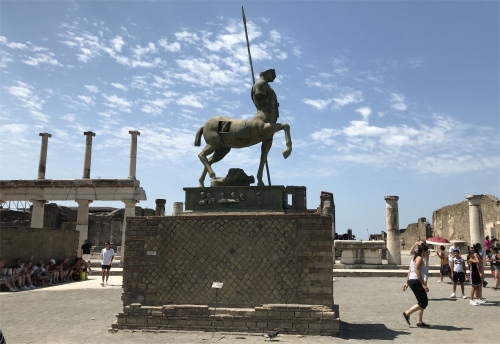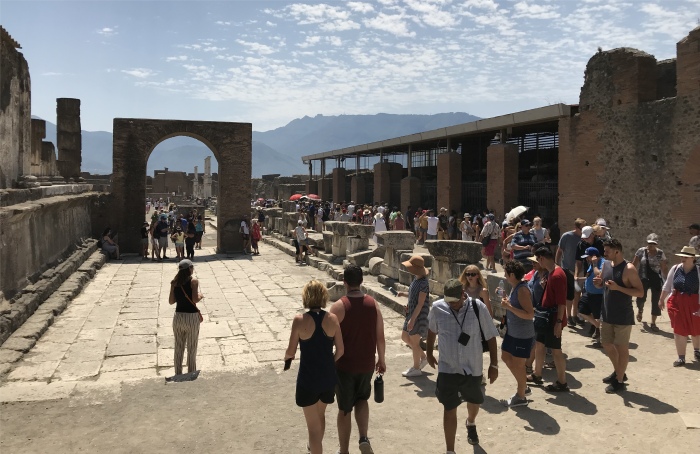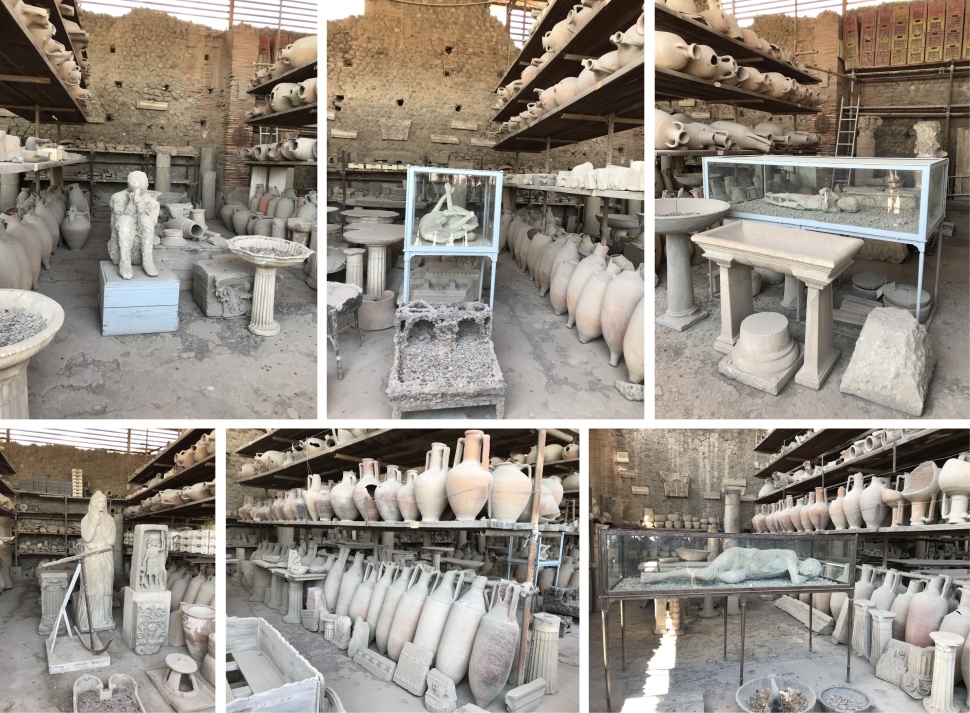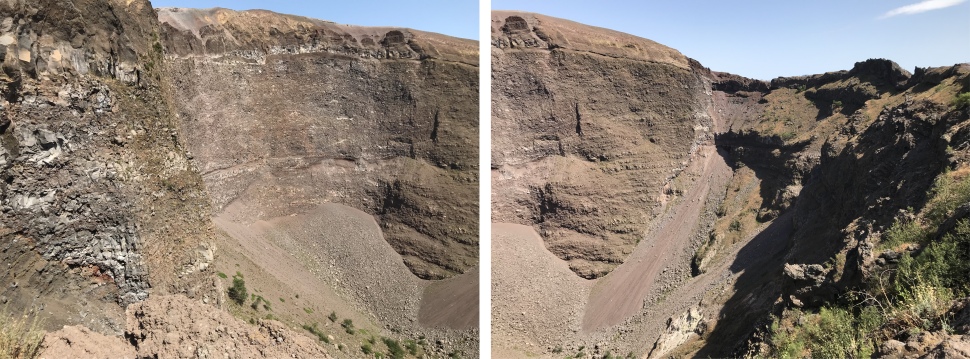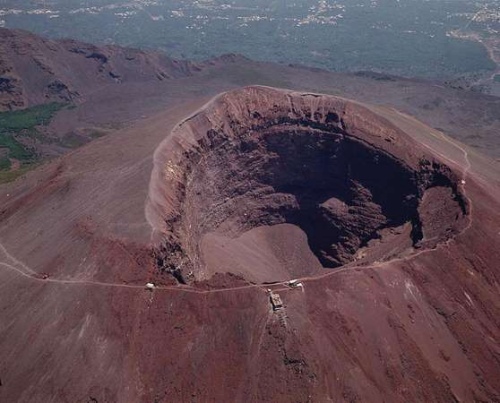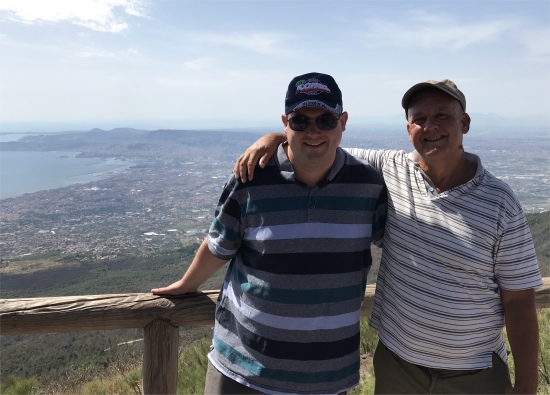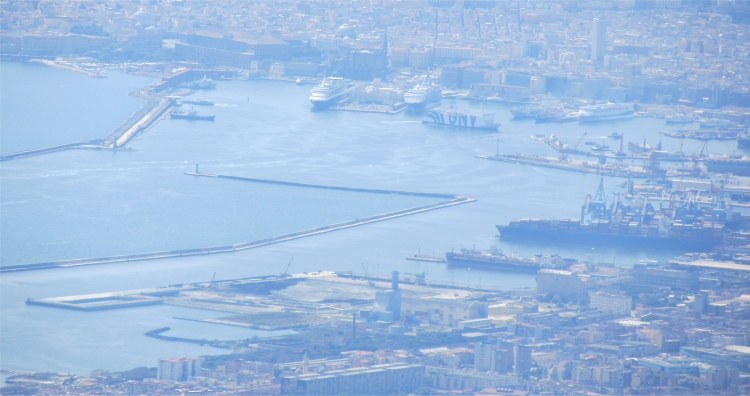We alighted at Piazza del Popolo, grabbed a quick coffee and croissant, and ambled across the square to meet our tour guide. He was a young, affable chap who had studied linguistics, translated, and also acted as a tour guide for 8 years.
Soon a large group of various nationalities was following the lad up to Viale Giorgo Washington, where we completely filled a coach, which whisked us up through the large park of Villa Borghese, and then out through the urban sprawl of Rome onto the E45. With a length of about 5,190 km (3,225 mi), the European Route E45 is among the longest north-south highways in Europe, stretching between Alta in northern Norway to Gela in southern Italy, passing through Finland, Sweden, Denmark, Germany and Austria. The Kattegat strait between Fredrikshavn and Gothenburg provides the link between Denmark and Sweden. While the term "E45" is in official use throughout its route, labelling and popular perception will often use national designators, especially in Germany. In this trip I had already travelled along the E45 on the Brenner Autobahn A13, Innsbruck-Italian border and on the motorway to Todi in Umbria.
As we sped along, our guide gave us an account of the history of Italy and Rome, a description of the region we were passing through, and a working knowledge of pizzas. I had never heard of the concept of white and red pizzas before. Pizzas have been around for quite a long time, but before tomatoes were introduced into Italy from South America (Peru, specifically) by the Spanish Conquistadors in the early to mid-16th century, all pizzas were white, basically ham and cheese. As for the Margherita pizza, a story often recounted holds that on June 11th, 1889, to honour the Queen consort of Italy, Margherita of Savoy, the Neapolitan pizza maker Raffaele Esposito created the "Pizza Margherita", a pizza garnished with tomatoes, mozzarella, and basil, to represent the national colours of Italy as on the Flag of Italy.
 Montecassino with Abbey Perched at the Very Top |
In 1944, during World War II, the abbey was the site of one of the most tragic battles of the European theatre of the war. The Allies mistakenly suspected that German troops were hiding inside the abbey and heavily bombarded the monastery, which actually housed many civilians who had sought refuge inside the building. The Battle of Monte Cassino was a turning point in the war, but at an incredibly high cost-in addition to the loss of the abbey itself, more than 55,000 Allied troops and more than 20,000 German troops, as well as countless civilians, lost their lives.
After the war, Montecassino Abbey was rebuilt for the final time. Fortunately most of its artefacts, including priceless illuminated manuscripts, had been moved to the Vatican in Rome for safekeeping during the war. The abbey was carefully reconstructed following the original plan and its treasures restored. It was reopened by Pope VI in 1964. It is a working monastery and active pilgrimage site, housing the remains of Saint Benedict and his twin sister, Saint Scholastica, which have managed to survive the events of the abbey's long and turbulent history.
As we continued our journey, our guide was keen to point out the Appian Way as we crossed it. This ancient road connected Rome to Brindisi, in southeast Italy. The road is named after Appius Claudius Caecus, the Roman censor who began and completed the first section as a military road to the south in 312BC during the Samnite Wars.
We then received a lecture on Pompeii before we skirted around Naples, with its high-rise buildings. Because the region is prone to earthquakes, many of these buildings were designed by a Japanese company, the Japanese having experience of building high-rise towers in earthquake prone Japan. The lad informed us that there are hardly any high-rise buildings in Rome - nothing is allowed to be built taller that St. Peter's Basilica dome.
16 miles south-east of Naples, we finally arrived at Pompeii. Here we were split into two groups of 25 people each, and our group was put under the guidance on a Pompeii expert, Bernadette. The lady did not waste any time, but took us immediately into the Quadriporticus of the theatres or Gladiators Barracks, where she proceeded to tell the story of Pompeii.
The many ghostly and well-preserved ruins of ancient Pompeii (Pompeii in Italian) make for one of the world's most-visited and engrossing archaeological experiences. Much of the site's value lies in the fact that the town wasn't simply blown away by Vesuvius in AD79, but buried under a layer of lapilli (burning fragments of pumice stone). The result is a remarkably well-preserved slice of ancient life, where visitors can walk down Roman streets and snoop around millennia-old houses, temples, shops, cafes, amphitheatres and even a brothel. The ancient site was added to the UNESCO World Heritage List in 1997, an excellent repository of details on quotidian life during Antiquity.
Although the Osci Tribe originally founded it, Greek settlers made the town part of the Hellenistic sphere in the 8th century BC. An independently-minded town, it fell under the influence of Rome in the 2nd century BC during the Peninsula's Social War, transforming it into a Roman Colony and naming it Cornelia Venera Pompeiana. Eventually the Bay of Naples became an attraction for wealthy vacationers from Rome who relished the Campania coastline.
By the turn of the 1st century AD, the town of Pompeii, located about five miles from the mountain, was a flourishing resort for Rome's most distinguished citizens. Elegant houses and elaborate villas lined the paved streets. Tourists, townspeople and slaves bustled in and out of small factories and artisans' shops, taverns and cafes, and brothels and bathhouses. People gathered in the 20,000-seat arena and lounged in the open-air squares and marketplaces.
In AD62, a mere 17 years before Vesuvius erupted, the city was struck by a major earthquake. Damage was widespread and much of the city's 20,000-strong population was evacuated. Villagers around the volcano had long learned to live with their volatile environment, and despite the massive earthquake providing a warning rumble of the disaster to come, people still flocked to the shores of the Bay of Naples. Pompeii grew more crowded every year.
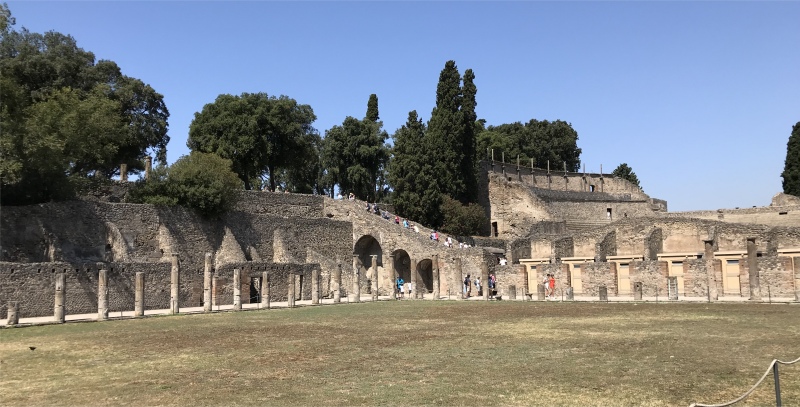 Gladiators Barracks |
In August 79AD, Mount Vesuvius erupted again. The blast sent a plume of ashes, pumice and other rocks, and scorching-hot volcanic gases so high into the sky that people could see it for hundreds of miles around. (The writer Pliny the Younger, who watched the eruption from across the bay, compared this "cloud of unusual size and appearance" to a pine tree that "rose to a great height on a sort of trunk and then split off into branches"; today, geologists refer to this type of volcano as a "Plinean eruption.") As it cooled, this tower of debris drifted to earth: first the fine-grained ash, then the lightweight chunks of pumice and other rocks. It was terrifying-"I believed I was perishing with the world," Pliny wrote, "and the world with me"-but not yet lethal. Most Pompeiians had plenty of time to flee. For those who stayed behind, however, conditions soon grew worse. As more and more ash fell, it clogged the air, making it difficult to breathe. Buildings collapsed. Then, a "pyroclastic surge"-a 100-miles-per-hour surge of superheated poison gas and pulverized rock-poured down the side of the mountain and swallowed everything and everyone in its path. By the time the Vesuvius eruption sputtered to an end the next day, Pompeii was buried under millions of tons of volcanic ash. About 2,000 Pompeiians were dead, but the eruption killed as many as 16,000 people overall. Some people drifted back to town in search of lost relatives or belongings, but there was not much left to find. Pompeii, along with the neighbouring town of Herculaneum and a number of villas in the area, was abandoned for centuries.
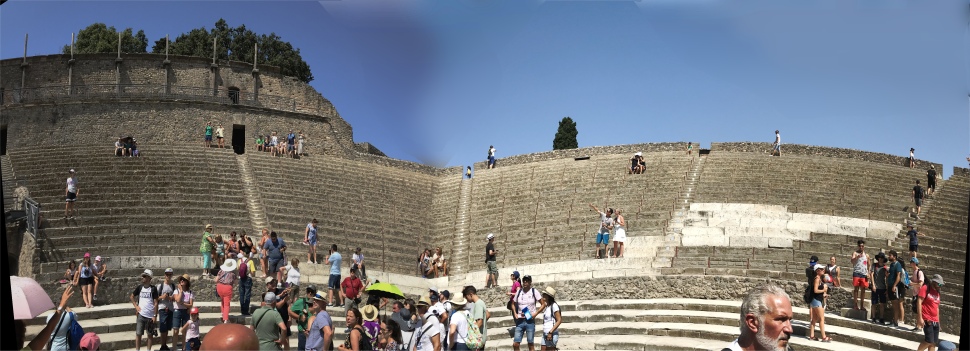 Large Theatre |
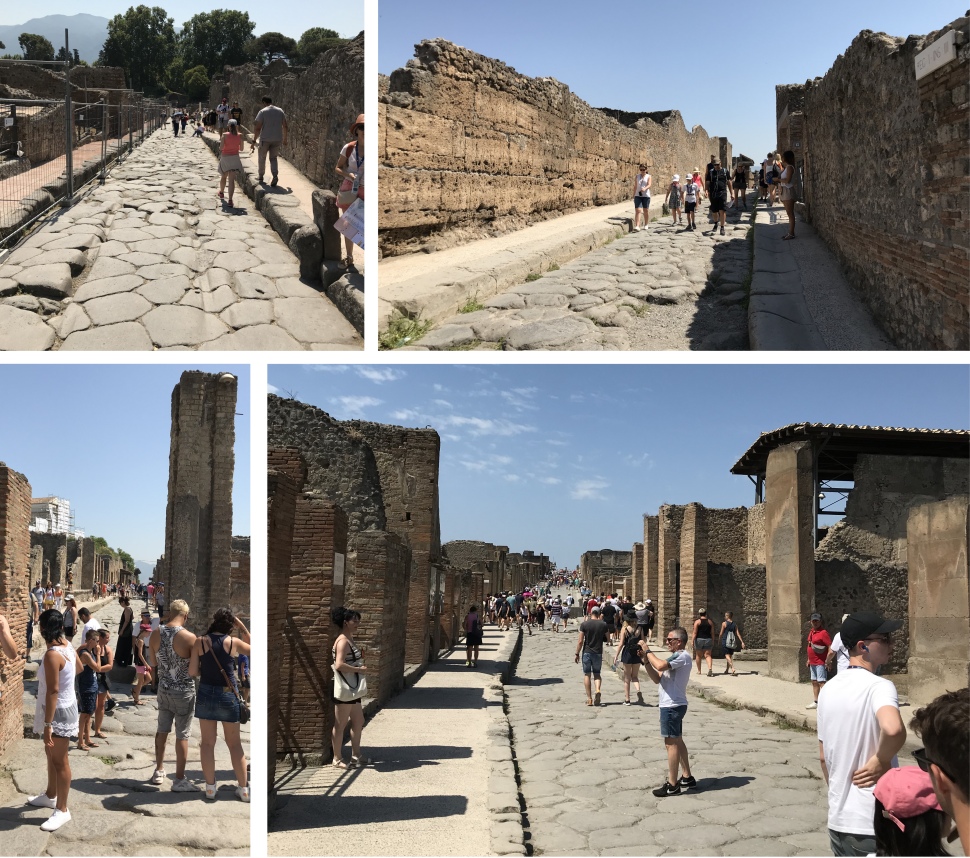 Pompeii Streets |
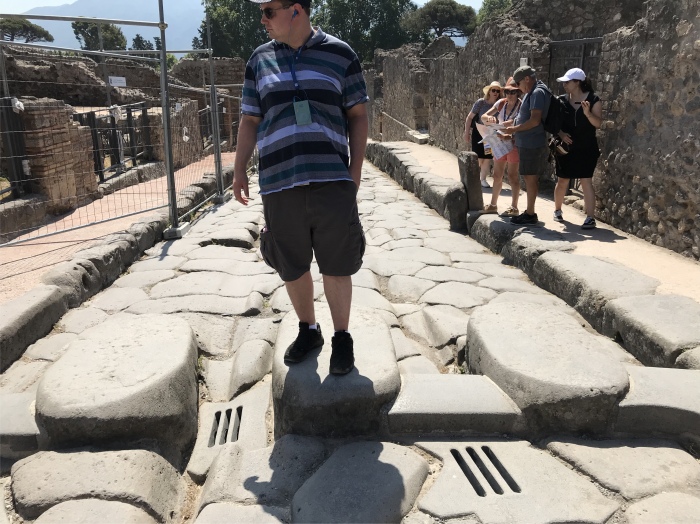 Street Stepping Stones - Drain Covers are Modern |
We then walked to the adjacent Large Theatre. It was built by exploiting the natural slope of the hill for the construction of the auditorium. The staircase was separated into three areas with corridors, which were in turn divided into five sectors, and was based on a passage with a barrel vault. It was built around the middle of the 2nd century BC and significantly restored according to the Roman style. An inscription is visible at the entrance of the corridor that provides access to the east. That is one of the very few representations known with reference to the name of the architects, and recalls the works carried out in the Augustan age by Marcus Artorius Primus. These works concern the scene and the stage, the adoption of the velarium, a large tarp used as a cover for the warmer days and the numbering of the seats. In the theatre they presented comedies and tragedies of Greek-Roman tradition. The theatre was the first large public building completely freed from the deposits of the eruption.
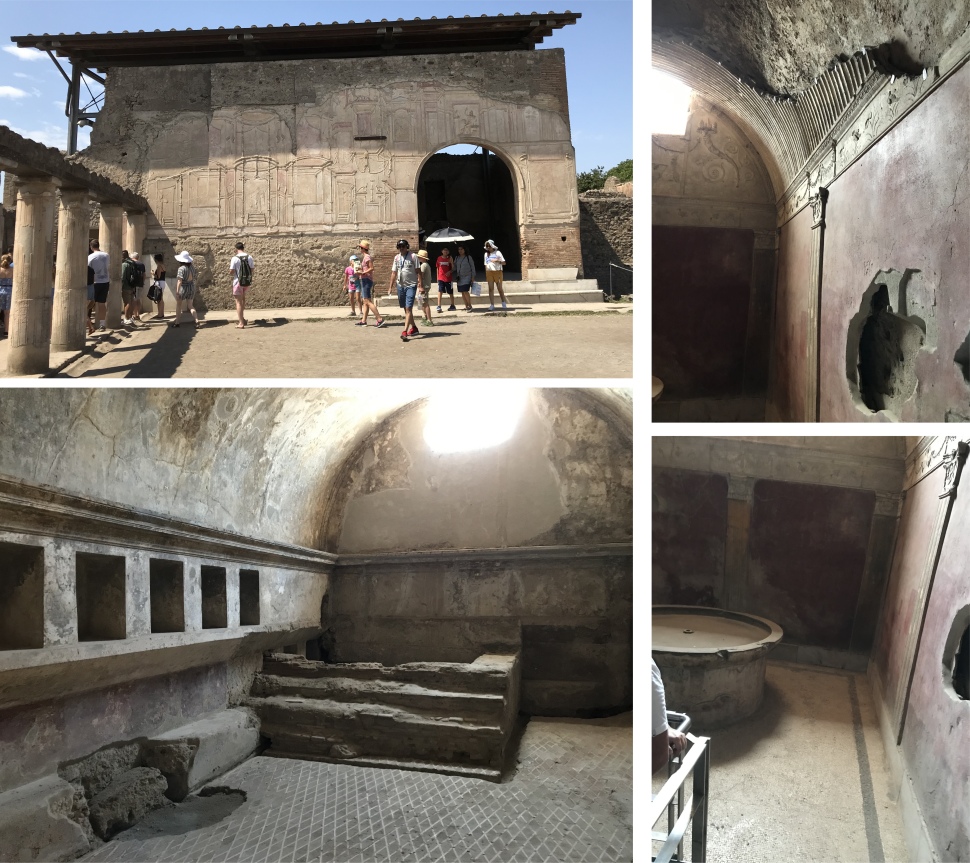 Stabian Baths - Note the Cavity Walls in the Hot Bath |




